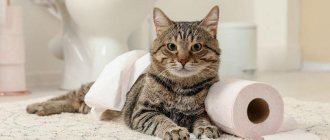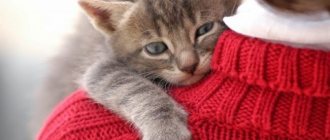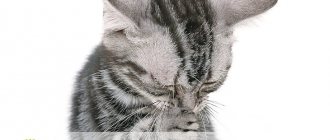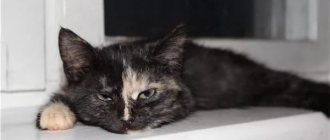Normal frequency of urination in cats
Those who have just bought themselves a mustachioed and striped friend often ask how many times a day a cat should pee. These animals initially existed with a lack of moisture, so they drink little, and their urine is extremely concentrated. Actually, this is what causes the specific and well-recognized smell of cat urine.
There is no need to be alarmed if your cat does not pee several times a day; it may happen once or twice a day. In principle, this is within normal limits, especially if the animal receives wet food and drinks very rarely and little.
This primarily applies to small kittens. Their urine is separated in minute quantities due to the fact that they feed on liquid food - mother's milk, which is almost completely absorbed by the kitten.
In addition, a caring cat constantly licks her kittens, so it may seem as if they are not urinating at all. Only after children begin to feed themselves can owners notice that they go to the toilet infrequently. This is also the norm for animals up to one and a half to two months.
It’s another matter if owners notice urinary problems in older animals. Normally, they can urinate 1 to 2 times a day. Frequent urination may indicate the presence of chronic renal failure (CRF), and too infrequent urination may indicate various health problems, including urolithiasis, which is very dangerous for cats.
Cats Lack of urination vetna
Unfortunately, cats quite often suffer from diseases of the genitourinary system. These animals are more susceptible to such diseases than other pets. Most often, this disease manifests itself in the fact that the cat begins to spin around the tray for a long time, meow, sit in and out of it. Urination may be intermittent and uneven. Such a situation requires immediate intervention from not only the owner, but also the veterinarian.
Causes
Lack of urination in cats can be caused by a variety of factors. It is worth noting that such problems more often occur in cats, not cats. This is due to anatomical features. The most likely causes: - The presence of sand, mucus, salts and stones in the canals of the urinary system. In this case, droplets of blood may be visible in the urine. If the disease is left unattended, the channels can become completely clogged; — Impaired kidney function. It is usually accompanied by loss of appetite, dehydration, severe exhaustion, and in some cases vomiting may be present. If the animal has kidney disease, the discharge will be cloudy in color; - Stress. In fact, cats are very sensitive creatures. Urinary retention can be caused by stress. If this is the reason, the animal must be given sedatives; - Infectious diseases. Bacteria and viruses can lead to many disorders in the body. The cat may urinate blood. It is worth noting that such deviations can be caused even by a common cold or simple hypothermia; — Impaired contraction of the bladder walls. This is usually the result of various injuries; “Tumors can also lead to such failures, but this happens in very rare cases.
Symptoms
How can you tell if your pet is in trouble? In most cases, diseases of the urinary system are quite noticeable; they can be identified by the following signs:
- The cat may start running to the litter box very often, but the discharge will be very insignificant; — Salt crystals, droplets of blood, and sometimes even tiny pebbles may be present in the urine; - The animal may not go to the toilet at all; - Touch your cat’s belly; the bladder will be very hard to the touch; finding it will not be difficult; - The cat can constantly spin around the tray, it will be clear that the animal is experiencing not only discomfort, but also pain; — On the second or third day, the pet will be very lethargic and apathetic.
The presence of at least one of these points indicates that not everything is in order with your pet’s body. It is almost impossible to independently determine what exactly the problem may be. To avoid possible serious complications, contact your veterinarian as soon as possible. Only after examination and tests will he be able to advise you on something specific. It is worth noting that the absence of urination for three days can lead to death, the probability of this is very high.
Treatment
The veterinarian will tell you exactly what the treatment will be only after a direct examination. In most cases, drugs are prescribed individually. This depends on the severity of the disease and the condition of the animal itself. In order to ensure temporary outflow of urine, the veterinarian will make a puncture in the abdominal wall. Usually, after the first procedures, the cat is given a special drug that eliminates dehydration and removes toxins from the body. Antibacterial medications are also often prescribed. If your cat has had urinary problems in the past, surgery may be necessary. To prevent a repeat of the situation, it will be necessary to expand the urinary canal. To ensure that complications do not arise again, be sure to follow all the doctor’s recommendations. Particular attention should be paid to dividing the food; the general condition of the body depends on it. For preventive purposes, a couple of times a year the cat can be given various vitamins and specially designed diuretics; they help eliminate the stones located inside. Always look closely at your pet, pay close attention to its behavior. In case of urinary retention, visit a specialist as soon as possible. Prompt treatment can save your cat's life.
Causes of urinary problems
There are many reasons why a cat does not pee as it should, so diagnosing the disease is very important. Only after receiving accurate results can the doctor prescribe the correct treatment.
The most common causes of difficulty urinating are:
- Kidney diseases. There are quite a few of them, they can be congenital or acquired, appear as a result of injury or disease.
- Urolithiasis disease. This is the most common and dangerous cause of urinary obstruction.
- Cystitis, or inflammation of the bladder and urethra. Occurs during infection or as a consequence of hypothermia against the background of a decrease in immunity.
- Atony of the bladder, appearing after injury, surgery, as a result of illness or old age.
- Anuria (lack of urine) is a critical condition, often leading to the death of the animal.
- Complications on the kidneys after infectious or systemic diseases.
- Spinal injuries with spinal cord damage.
- Formation of tumors (benign or malignant).
INTERESTING TO KNOW: Symptoms and treatment of gastritis in cats
In any case, if the cat cannot pee, contacting a veterinary clinic is vital, since without an accurate diagnosis it will be impossible to carry out the correct treatment.
3. Symptoms and diagnosis
In some cases, infrequent urination may not be accompanied by any additional symptoms and/or sensations. However, if the reduction in the frequency of urination is not purely situational, physiological, transient, then the asymptomatic period sooner or later ends and gradually increasing signs of the true, pathological cause of urinary retention and/or reduction in daily urine volume appear. Such symptoms are most often associated with the mictional (urinary) act of pain, pain in the lower abdomen (of various types, often radiating to adjacent areas), forced tension, without which urine does not begin to flow, a feeling of incomplete emptying of the bladder, weakening, bifurcation or unusual spraying of the stream, dependence of its emission on body posture (in some cases, for example, if there is a stone in the urinary tract, urination becomes possible only with a certain tilt or turn) and other uncomfortable sensations. Sometimes rare urination is combined with drip “leaking” or other forms of urinary incontinence (for example, the urge appears suddenly and almost immediately becomes imperative, unbearable).
The cause is established during a urological examination, collecting anamnesis and complaints (signs such as complexion, characteristic swelling, rapid loss or gain of body weight, etc. are also important), studying the dynamics, as well as additional diagnostic procedures. Sometimes, to identify a pathological factor, a rather long, thorough and multifaceted examination is necessary, incl. application of modern methods of instrumental and laboratory diagnostics. As necessary, tests of urine, blood and other biological media are prescribed (clinical, biochemical, hormonal, bacteriological, etc.), modifications of X-ray studies accepted in urology (survey and excretory contrast urography), urocystoscopy, ultrasound, CT, MRI etc.
About our clinic Chistye Prudy metro station Medintercom page!
Signs of problems with the urinary system
If the owner notices that his cat cannot pee, spins around in the tray, sits down, but nothing happens, this is a reason for serious concern and a visit to the veterinary clinic.
Any signs of trouble should be of concern - “empty” visits to the tray, screams or meowing during urination, small or excessively large amounts of urine, changes in its color and smell, the appearance of turbidity, flakes, sand or traces of blood in it.
Urinary disorders may be accompanied by increased lethargy of the animal, severe thirst or refusal to drink and/or eat, high or slightly elevated temperature, and drowsiness. Often a sick animal hides in a corner, stops playing, may scream pitifully or even growl at its owners when they try to feel it, sometimes the cat meows when they try to pick it up.
If a cat does not pass urine for a long time (more than a day), and the condition is accompanied by the symptoms described above, it must be urgently taken to a veterinary clinic. Such manifestations can be signs of serious diseases; the introduction of stones or tightly packed sand into the ureters or urinary tract is especially dangerous. Delay can cost the animal its health or even its life.
What complications does coronavirus cause to the kidneys?
Kidney diseases after Covid are associated with inhibition of cell function - traces of viral DNA are found in the urine of patients, which indicates its presence in the urinary system. Most often, the condition is expressed in renal failure - acute, turning into chronic.
Acute kidney damage is one of the factors of mortality from Covid in severe cases of the disease, therefore screening is necessary as quickly as possible. In some patients, sluggish and hidden disorders in the urinary system appear immediately when they become ill with coronavirus.
Treatment options
In cases where the cat does not pee, only a veterinarian can decide on the choice of treatment. In a number of situations, only the fastest surgical intervention can save the life of an animal, so you cannot hesitate in such a situation.
Very often, owners are interested in what to do if the cat cannot pee. The animal must be shown to the veterinarian and await his conclusion. Depending on the disease, specific treatment will be prescribed.
If the disease is bacterial in nature, antibiotics will have to be used; in other cases, antiviral, anti-inflammatory, painkillers, diuretics, antihistamines and other drugs, as well as steroid hormones (if required), will be prescribed. These drugs must be given strictly according to doctor's orders.
A sick cat needs love, affection, a warm, cozy place to sleep, and proper feeding and drinking regimen. She will need a special diet of foods that cannot irritate diseased kidneys and urinary organs.
Dry food, especially cheap food, must be removed from her diet. It is not of high quality and has an extremely negative effect on urinary function. It contains few natural products, especially meat, and mainly contains carbohydrates, fats, various additives, flavors that attract cats, and dyes.
In addition, it contains a lot of salt, and swelling in the cat’s stomach, such food severely dehydrates the body. Long-term feeding of such foods in itself can lead to impaired kidney function, and in the presence of a disease this is especially dangerous.
During an acute condition, the kidneys should not be overloaded with protein foods, so a lot of attention should be paid to the cat’s nutrition. Until the condition stabilizes, her food should be light, natural, unprocessed and sufficient in calories.
Since urolithiasis in cats is a fairly common phenomenon, and it mostly affects cats, especially castrated cats, urethrostomy is used as a preventive or therapeutic measure. Due to the severe narrowing of the urethra at the exit, even a small amount of sand can lead to the death of the cat. The new urethral opening is created between the scrotum and the anus.
This operation can save the animal’s life, but will require more attention and care from the owners, since the frequency of bacterial cystitis can triple.
4.Treatment
Rare urination is always a symptom of pathology or at least an anomaly, but this symptom itself cannot be treated: of course, the disease, the etiopathogenetic root cause, must be treated. Accordingly, therapeutic strategy and tactics are entirely determined by the diagnostic results; In addition, prescriptions always take into account many purely individual characteristics, so it is impossible to outline at least in general terms all possible schemes of treatment prescriptions. It should, however, be emphasized once again: urinating too infrequently is just as serious a symptom as urinating too often, and in any case you need to take it seriously: consult a doctor as soon as the tendency becomes obvious, and not wait until much more severe manifestations and complications.
Reasons why a cat cannot go small
The most common reason why a cat does not go to the toilet is sand or stones. They close the ducts, as a result, urine cannot escape. At the same time, if pebbles still pop out with urine, this is accompanied by injury to the mucous membrane and its inflammation. Other reasons when a cat cannot go to the toilet for a little while :
© shutterstock
The reason why cats have difficulty going to the toilet in small children can be various kidney diseases. Sometimes a delay of several days is caused by congenital abnormalities of the excretory organs. However, this is a rare reason. In this case, symptoms of an abnormal structure may not appear in a kitten, but already in adulthood.
The risk category, when an animal cannot go to the toilet when it is small, mainly includes cats whose owners neutered them in early childhood. Moreover, the delay is more common in males. If the problem occurs in a newborn kitten, then 90 percent of the cause is congenital problems of the genitourinary system.
Household reasons
A cat will sometimes not go to the toilet due to everyday factors. For example, if the animal’s tray is dirty or there is a lot of uncollected urine. It happens that after moving to a new place, a cat experiences severe stress. This may be accompanied by delayed bowel movements. The cat will first inspect the room and determine a corner for rest. Then he will find a place where he will go for small walks.
Symptoms of constipation and delayed bowel movements
Signs that a cat has problems with bowel movements are immediately noticeable. The animal becomes nervous, there is no feces in the tray. The cat makes frequent but useless attempts to defecate. He can dig for litter for a long time, sit in the tray, meow plaintively or shrilly.
© shutterstock
This condition is considered relatively normal for old cats and young kittens. However, even they should have bowel movements at least once every 2-3 days. Other symptoms include :
- lethargy of the cat;
- the animal's refusal to eat;
- lethargy;
- swollen belly;
- tense and hard stomach.
The cat may not allow its owner to come near it to avoid unnecessary pain. The animal tries to lie on its side, but not on its stomach. Neutered cats experience constipation more often than their full-fledged counterparts.
Symptoms of urinary retention
Symptoms of urinary retention are in many ways similar to those of constipation. The cat rarely goes to the toilet, despite the animal's frequent urges and attempts to pee. During the process itself, a loud and plaintive meow is heard. This indicates that the cat is in pain. Other symptoms when an animal cannot go to the toilet normally :
- purulent discharge and blood may appear in the urine;
- the stream is crooked and can get past the tray, beyond its limits;
- sometimes after urination small crystals are visible and foreign bodies come out;
- the cat does not always have time to run to the toilet (especially if it could not go to the toilet for a very long time);
- urine color darkens;
- emptying the bladder does not bring relief, since it is not completely emptied.
© shutterstock
The animal (even a small kitten) becomes aggressive, hisses, and does not allow itself to be touched, especially its swollen belly.
Reasons why a cat can't poop
If a cat simply cannot go, this could be for several reasons. Moreover, the provoking factor is not always diseases. For example, the cause may be a foreign body that the cat swallowed.
© shutterstock
These can be bones, small objects, matted tufts of fur that the animal swallows during exercise. If all of the above is not removed in time (and this is only possible through surgery), then the cat may die from intoxication of the body.
Other causes of constipation include:
- Cysts, benign or malignant tumors that greatly impede the passage of food through the gastrointestinal tract.
- Anal lacerations. Such injuries cause severe pain to the cat, so she tries not to walk around too much.
- Problems with the anus. The rectum may become inflamed and sphincter scarring may form. Since bowel movements are very painful, the cat tries to endure it until the last moment.
- Obstruction or slowing of intestinal motility often occurs due to compression of the organ. This condition is provoked by tumors, adhesions, hernia or torsion. The intestines can be compressed by nearby internal organs, which increase in size.
- Inflammation of the digestive system often leads to prolonged constipation. As a result, the contents of the intestines begin to rot inside the organ. Gradually, the feces harden and cannot exit through the anus.
Poor diet often leads to constipation in cats. The reason lies mainly in the absence or lack of water in the bowl. As a result, dry food constantly moves through the gastrointestinal tract. This slows down digestion, damages the mucous membrane, and with prolonged stay in the intestines, intoxication of the body with rotting products begins.
© shutterstock
Problems with constipation also depend on the age of your pets. Little kittens and old pets go to the toilet very rarely. However, even they must poop at least once every three days. Constipation is often quite easy to resolve. You need to make sure that your cat always has plenty of clean water in his bowl. You also need to add more fiber to your pet's diet.











